How To Take Care Of Outdoor Potted Plants Over Winter
Unlike annuals, which experience their entire life cycle in a single growing season, perennials return year after year. The stems, leaves and flowers of perennial plants typically die back each winter and regrow the following spring from the same root system. Perennials aren't immune to cold weather. Harsh winters can kill these plants, but you can take precautions to protect your potted perennials during the winter.
Step 1
Step 1
Buy pots with drainage holes and fill them with well-draining compost. Over winter, potted plants are exposed to excessive moisture caused by winter rain. Wet, soggy soil can starve a plant of oxygen and effectively drown it. Drainage holes and the right compost alleviate this problem.
- Unlike annuals, which experience their entire life cycle in a single growing season, perennials return year after year.
- Harsh winters can kill these plants, but you can take precautions to protect your potted perennials during the winter.
Step 2
Step 2
Stop fertilizing outdoor potted plants by midsummer but continue to water them regularly through fall to prepare the plants for winter. This reduces new growth, which is vulnerable to frost.
Step 3
Step 3
Place outdoor potted plants on pot feet. Pot feet raise a container two to three centimeters above the ground, which provides air circulation and allows excess moisture to escape through the drainage holes.
Step 4
Step 4
Move tender plants to a frost-free location, such as shed, garage, greenhouse or indoors, before the first frost. Frost can easily pierce the sides of pots — especially those made of terracotta — and kill roots.
Step 5
Step 5
Cut hardy perennials that stay outside back with garden pruners so that the remaining stems are between 4 and 5 inches above the soil line. This is best done after the first frost when the leaves drop.
- Stop fertilizing outdoor potted plants by midsummer but continue to water them regularly through fall to prepare the plants for winter.
- Cut hardy perennials that stay outside back with garden pruners so that the remaining stems are between 4 and 5 inches above the soil line.
Step 6
Step 6
Wrap the outside of outdoor pots with sheets of plastic packaging material and secure with garden wire. The wrap protects the potted plants from cold weather.
Step 7
Step 7
Move the outdoor pots against the house and pack them tightly together. The wall of your home is slightly warmer and can act as a barrier to freezing winds. In addition, closely packed pots insulate each other.
Tip
If you have several potted plants that must remain outdoors, position them close to your house and wrap the collective group with sheets of plastic packaging material. This saves on time, and the pots insulate one another better than when they are wrapped individually.
Warning
Wear gloves when working with compost to protect against soil-borne pathogens. Store the plastic wrap, wire and pruners out of the reach of small children.
Things Needed
- Bubble wrap
- Garden wire
- Garden pruner
